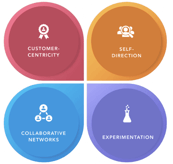For many, Agile is associated with the technology part of your business or one or two pockets in your organisation. It is often thought of as set of routines and practices – stand up meetings, retrospectives, Kanban, etc. We refer to this as DO-ing agile.
However, simply engaging in these practices is not enough for organisations to be strategically ready to adapt to whatever the market requires of them. To be in this position, requires a much more fundamental cultural transformation involving shifting mindsets, behaviours, symbols and systems – BE-ing agile or having an agile culture.
So, what is an agile culture?

Culture is the patterns of behaviour that are encouraged, discouraged or tolerated by people and systems over time. We were excited to discover in our research four distinctive patterns of behaviour of an agile culture – customer-centricity, self-direction, experimentation and collaborative networks which are interdependent and need to occur together to realise the full organisational benefits of Agile.

Head Office / Europe:
+31 (0) 20 240 2233
North America:
+1 (0) 212 417 0221
UK: +44 (0) 207 100 6999
Asia Pacific: +61 (2) 8310 5285
Brazil & Latin America: +55 (11) 932 500 683
(WhatsApp available)